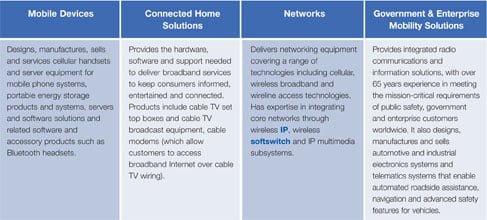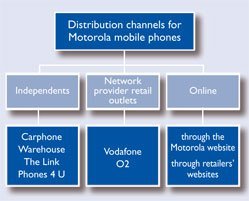
Marketing involves finding out what your customers want and then meeting their requirements. To satisfy its customers, a business must create a successful mix of:
- the right product or service
- sold in the right place
- at the right price
- using the most effective forms of promotion.
This is sometimes referred to as the 4Ps.
This case study shows how Motorola has created an effective marketing mix for its mobile phones in a highly competitive marketplace.
Motorola began life as The Galvin Manufacturing Corporation in Chicago in 1928. Its first product was a battery eliminator, enabling radios to operate from mains electricity rather than expensive batteries. In the 1930s it produced car radios using the brand name ‘Motorola’. The company later adopted Motorola as its name.
The company is now known around the world for innovation and leadership in wireless and broadband communications. Motorola’s vision is Seamless Mobility, which the company defines as helping users get and stay connected easily to the people, information, and entertainment that they want and need. The company does this by designing and delivering ‘must have’ products, ‘must do’ experiences and powerful networks.
Applying this vision to mobile phones, Motorola has gone beyond just enabling users to make voice calls or send text messages. Depending on the models chosen, users can:
- share music files between the user’s PC and their phone
- play that music easily on stereo BluetoothTM headphones
- in the car – as well as being able to use the phone with a hands-free car kit, play music through the car stereo
- at home, play the music through your stereo system.
Product

The first element in the marketing mix is the product itself. If you create products that customers want, the other parts of the mix can be designed to meet customer needs.
Motorola is a global leader in wireless and broadband communications technologies and related electronic products. It has significant operations in the UK employing approximately 2,400 people. It covers a number of businesses.
Mobile phones are among the most familiar products to consumers and the mobile phone is seen by many as an essential item. It can perform a number of functions, including being:
- an essential means of communication
- a fashion statement
- a source of entertainment such as music and video games
- a safety precaution (e.g. to tell people where you are).
The mobile phone market has risen dramatically in size. In April 2005, the market research company Mintel produced figures which showed that 80% of the youth market in the UK has a mobile phone, and that over 61 million people subscribed to an airtime contract.
The market is a very competitive one with a range of companies competing to provide mobile phone services. With a 3G or WAP-enabled phone, customers can browse special Internet sites, which means they can look at football scores, search cinema movie times, or live-chat with friends. Motorola has partners such as MTV, with high quality sites providing diverse and entertaining content. 3G (third generation) phones offer much more effective access to music and video downloads, because the networks they work on provide faster connections for downloading content than previous generations of phones.
Text, Picture and Video messaging is phenomenally popular and is likely to become more so. Motorola mobile phones are increasingly being used to capture and share experiences, in addition to making arrangements, tell jokes, and flirt without the personal nature of a face-to-face or voice-to-voice contact.
In creating products, Motorola concentrates on:
- attractive design
- excellent call-quality
- ease of use
- value-added features including music player, games, camera, and video features
- high quality, reliable products.
In order to remain competitive, the company continually seeks to innovate – for example by building phones that are slim and well designed. This is particularly important for one group or segment of the mobile market. An example of this is the Motorola RAZR phone.
The Motorola RAZR V3i is the thinnest clam-shell phone currently available (as at January 2006), just 13.9mm thin. The casing is made from aircraft grade alloy, and the outer screen is from glass, as no conventional plastic materials were strong enough.
It has a built-in camera with 4X zoom and quick exposure controls. This also lets you watch and record video clips in full colour. You can also enjoy your favourite ring tones, music clips and games with a state-of-the-art polyphonic speaker sound and an integrated 3D graphics engine.
Price

Price is the one element of the marketing mix which creates sales revenue – all the others are costs. For companies like Motorola, price is a key element in the marketing mix. It is a critical selling point. ‘Getting the price right’ is a vital part of building relationships with customers.
As with other companies, prices charged by Motorola are linked to the product life cycle. When a new product is launched prices will typically be quite high. This is because a lot of product and market research has gone into producing the product. It usually takes time for large numbers of consumers to purchase new products. For example, 3G phones are only just beginning to sell in large quantities. As a product matures and sales increase, it is possible to reduce costs.
Economies of scale are important. These come in when a firm is able to produce on a large scale. With high outputs of production, costs of research and development, software engineering and investment in plant (manufacturing machinery and tooling) can be spread. State-of-the art products are sold at premium prices reflecting the high quality of the items and their innovative nature.
The costs to the users of Motorola mobile phones are kept down because they are subsidised by the network providers such as Vodafone. Network providers want as many people as possible to subscribe to their network. They therefore like to link with the producers of the best designed phones which feature the most exciting and effective technologies. Phone retailers will often supply free accessories with a mobile phone to make it more useful to phone users and to encourage them to buy.
Place
Though figures vary widely from product to product, roughly a fifth of the production cost of an item goes on getting it to the customer. The term ‘place’ deals with various methods of transporting and storing goods and then making them available to the customer.

Getting the right product to the right place at the right time involves the distribution system. Distribution is the process of moving goods and services to the places where they are wanted.
There are a number of ways in which Motorola distributes its phones. If you want to buy a Motorola mobile phone there are a number of distribution channels that you can use. Many people like to buy phones from independent retailers such as Carphone Warehouse. These can offer advice about a variety of different phones and suggest the one best suited to your needs. A second source is a retail outlet belonging to a network provider such as Vodafone.
Nowadays, increasing numbers of people buy through the Internet. This is an example of e-commerce. The great thing about buying online is that you can spend as long as you like and examine a lot of information. You can buy a Motorola phone from the Motorola website. It will tell you about different models of phones, their prices and features etc.
An advantage of buying online is that prices are typically cheaper because you are cutting out the middle person. The site is managed for the company by a third party who processes the orders and delivers the mobile phones/accessories to customers.
The place where you are able to buy sometimes depends on the product. Some companies like Motorola often give exclusive offers to certain retailers. For example, when Motorola first introduced the pink RAZR in the UK, it was exclusively available through Carphone Warehouse. In contrast, 3G phones, are mainly sold through retail outlets of 3G networks. The reason for this is that the product fits closely with the distribution channel.
Promotion

Promotion includes all of the techniques that a company uses to communicate with other individuals and organisations. Companies like Motorola send communications and consumers receive them.
An important avenue for communication is advertising. Advertising is referred to as ‘above the line’ promotion. Other types of promotion such as special offers and discounts are referred to as being ‘below the line’.
The type of promotion that is used depends on the stage in the product life cycle. For example, when a new product is launched, such as the RAZR, it makes sense to make people aware. Advertising will communicate the desirability, emotional benefits and exclusive features of the product.
Motorola works in close partnership to promote its phones with retailers. Promotion costs are shared with retailers. The more retailers sell – the more Motorola is able to help them.
Conclusion

Motorola is an exciting high-tech company. Its vision is to provide seamless mobility. In the modern age, communication and the sharing of information is a major goal of consumers. They want to be able to share a joke with friends, access important information on the move, listen to music of their choice. In short, to make best use of their time and the communications available to them.
Motorola has invested heavily in providing a range of products that enable people to communicate on the move. These products are supported by other elements of the marketing mix – the right price, in the right place, with appropriate promotion. In a highly competitive market Motorola needs to regularly adjust this marketing mix in line with the changing requirements of millions of customers.
